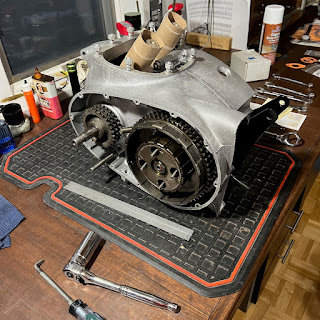The clutch was a bit knackered but still probably functional as it was found. The primary chain was stretched out as the "Wardmaster socket" under the adjusting pad would indicate. This has been a common occurrence found on old bikes when I tear them apart, although two out of three had lug nuts under them. Chains must have been expensive, hard to find. or not considered worth replacing "back in the day".
It makes a seemingly impossible job very possible.
New bearings, friction plates, greased and ready to go.
Sprockets fit without the chain to check alignment. All is good....
Primary parts ready for final installation & a timing disc setup being worked out. The final assembly will be done in the frame. On to the transmission & timing side.....
This will be revisited when the wiring is finished and the electronic ignition needs to be set.
Assembly of the primary side was pretty straightforward. The rotor and stator went on passing the dollar bill test with no adjustments needed. The stator wires were fished through the case via the zip tie I had installed earlier. I am glad I did not forget that step as it is a real time saver
Although I have never done this before I lightly oiled the clutch plates with type F automatic transmission fluid. I have always assembled them dry and they are usually oil soaked when removed. An expert in the field recommended lightly oiling them so I will give it a try. One thing that gave me fits was installing the clutch springs. Try as I might I could not get the retainer nuts to catch. After working a short while I decided to check the new springs I purchased to the originals. To my surprise they are .50 inches longer. The Lightning Rocket is specked for these longer springs although the standard Rocket springs came out of my clutch. I ordered a set of standard springs which are .25 inches longer than the originals but could not get them in either. Back to the original springs. The situation will be addressed at a later time if necessary. Maybe a special tool? Longer retainer screws?
Primary assembled and it's on to the timing side.














